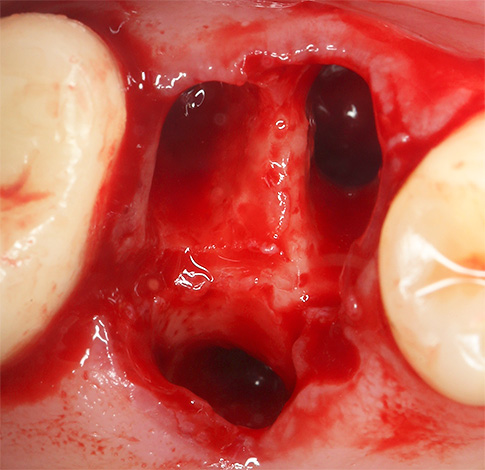
Tooth extraction is a rather complicated surgical procedure associated with the forced dislocation of a tooth from a hole, in which it is firmly held by living and well-supplied blood. As a result, these tissues break, connecting the tooth with the walls of the hole and with the gum, and bleeding occurs, which does not always stop quickly.
On how to stop the blood after the removal of the tooth, if it would seem, does not want to stop, we will continue and talk in more detail.
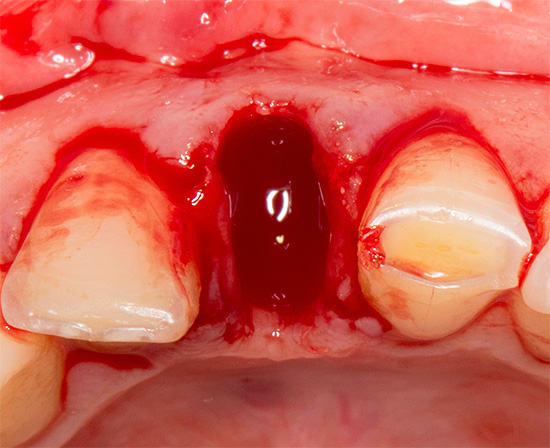
It is interesting
Sometimes it happens that immediately after the removal of a tooth, there is practically no blood in the hole, as the adrenaline added to anesthetics in certain cases causes a temporary spasm of the periodontal vessels. At the same time, there is a real risk of the so-called “dry hole” effect, as a result of which a protective blood clot playing an important role may not form at all, which means that a reliable biological protection of the wound from infection does not form.
It is important to understand that bleeding from the hole, which arose after the extraction of the tooth, is a normal and natural process that only needs to be monitored by the doctor and the patient. Most often, the average person does not even have to think about how to stop the blood after a tooth is removed, since the dental surgeon performs a number of necessary actions that create all the conditions to prevent further bleeding.
However, there are still cases where after a tooth is pulled out, the blood does not stop for a very long time. Unfortunately, sometimes in patients this causes a real panic fear (usually already at home): blood from the hole goes and goes, and abundantly, and fears arise in a person's head that one can simply bleed to death and die.
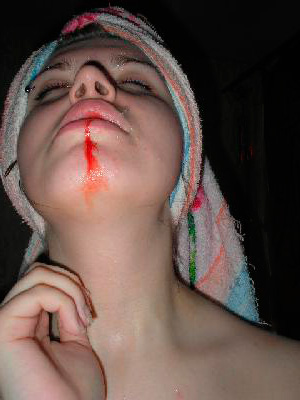
On a note
Deaths resulting from a large loss of blood after tooth extraction are extremely rarely recorded. The last sensational case refers to 2009, when a few hours after the removal of three teeth at once, a resident of Great Britain Paulina Wheels died from heavy blood loss. However, not everything is so simple: the deceased woman had serious health problems (cirrhosis of the liver and poor blood clotting), as well as a passion for alcohol.It is alcohol that often becomes a provoking factor for death from a variety of complications.
It is almost impossible to die from blood loss as a result of tooth extraction, but it is quite possible to get serious problems in various organs and organ systems. Therefore, it is useful to be well aware of the main causes of long-term bleeding from a hole after tooth extraction, how much blood is normal in a healthy person, and how at home you can effectively stop the blood to prevent undesirable consequences.
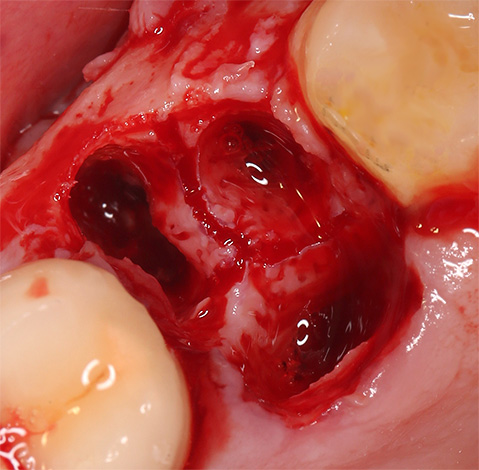
Why does a hole sometimes bleed for a long time after tooth extraction?
As a result of trauma to the tissues surrounding the tooth, bleeding occurs, which normally leads to the appearance of a full blood clot in the hole for several hours, which becomes a reliable barrier to infection from the oral cavity to the surface of a fresh wound. If a blood clot does not form after the removal of a tooth, and the blood continues to flow, then we are talking about primary bleeding.
If the hole in the place of the tooth pulled out first stops bleeding, but then after some time the blood begins to flow again, then we are already talking about secondary bleeding.
Most often, after a tooth is removed, the blood does not stop for a long time due to local factors, namely, as a result of a traumatic operation with a rupture of soft tissues containing relatively large vessels, and a bone injury to the alveoli.
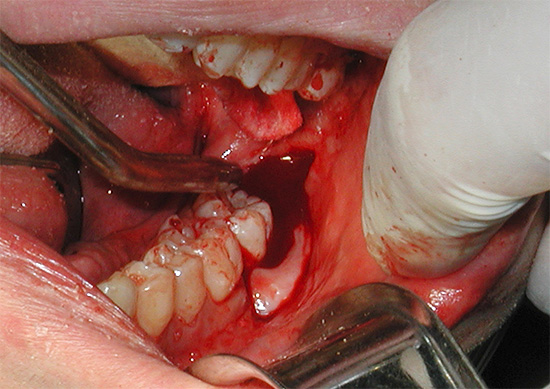
From the experience of the dentist
Unfortunately, sometimes you have to face the unprofessional work of your fellow dental surgeons, when people come to the reception with complaints of long bleeding, severe pain and gingival suppuration after negligent and excessively rough extraction of a tooth or several teeth at once. The result of the operation is visible to the naked eye: the gums are smashed, the cheek mucosa or even the lips are torn, part of the bone protrudes from the wound, not covered by the gum, fragments can even be pointed to the touch, part of the alveolar jaw can be broken off (but, thank God, this barbarism is allowed extremely rarely).
When major dental arteries are damaged, blood flows from the depths of the hole. Severe bleeding is often triggered by acute inflammation of the tissues surrounding the aching tooth, since, against the background of a pronounced inflammatory reaction, the vessels in them are greatly expanded and may not subside.After the adrenaline from the anesthetic (pain-relieving injection) ceases to act, vasodilation may occur, and, as a result, the blood will not begin to flow immediately after the extraction, but only a few tens of minutes or a couple of hours.
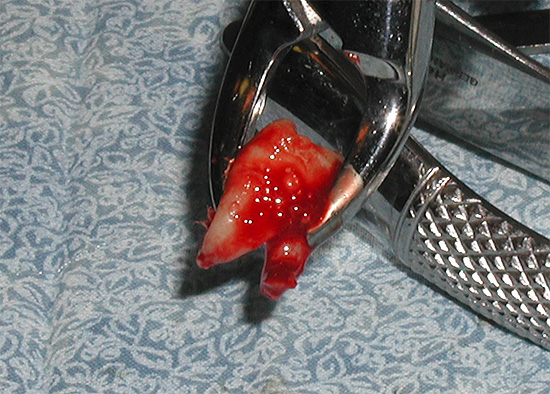
There are also common causes, against which prolonged primary and secondary bleeding is provoked., namely:
- Disruption of the blood coagulation process or damage to the vascular system as a result of diseases (hemophilia, acute leukemia, Verlgof's disease, and some others);
- Acceptance of indirect anticoagulants or heparin;
- Hypertonic disease.
If the bleeding is not stopped immediately after the tooth is removed, then the general health of a person may worsen due to prolonged blood loss: weakness often appears, dizziness, skin becomes pale, pulse increases, blood pressure decreases. Despite the fact that deaths from bleeding from the hole are rarely fixed, all necessary measures should be taken to stop the blood as soon as possible and return the body to its normal state.
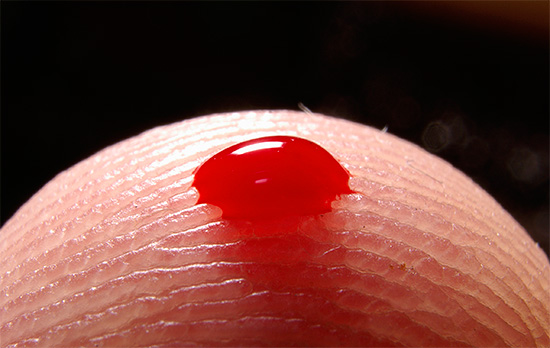
How long should the blood flow from the well in normal?
After the tooth is removed, the dentist-surgeon, depending on each specific situation and taking into account the instructions and indications, decides on stopping the hole's bleeding in an accessible and acceptable way at the moment. The normal process of formation of a full blood clot usually falls within the range of 10-15 to 30 minutes.
Thus, if you continue bleeding or started after the procedure, that is, at home, then this is not the norm. In this case, it makes sense to call the clinic and get the appropriate advice.
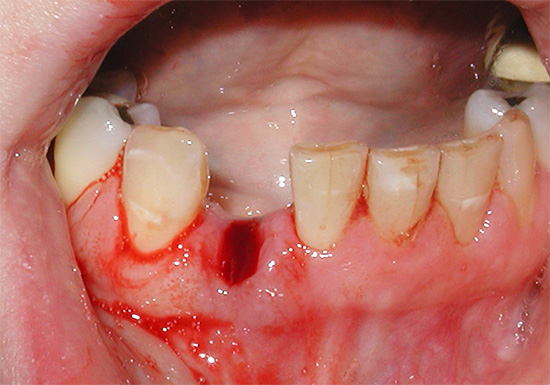
However, there are situations when the patient confuses bleeding with the release of blood from the hole, which can be observed up to several hours after the removal of the tooth. Sucker is a colorless or yellowish liquid with a small admixture of blood, the appearance of which is not a sign of complication. Sometimes such secretions can accompany a person for more than 12 hours, but with varying degrees of intensity. There is absolutely no reason for concern in such situations.
Feedback
Three days ago, they pulled out my upper wisdom tooth.Moreover, they were removed long and painfully (they even tapped with a hammer), then they forced me to bite a piece of gauze and sent it home. An hour later, such a severe pain began that I had to take a pain pill, and then I fell asleep.
I woke up a couple of hours from the fact that there was a lot of blood in my mouth. She found a piece of sterile bandage in a medicine cabinet, cut off, bit and went with him like an abnormal 30 minutes. At first it seemed that the blood stopped, but then a strange liquid formed in her mouth: not saliva with blood, not pus, it is not clear. Somehow I survived the night and went to the morning to the same doctor that pulled my tooth out the night before. The dentist said that it was a bastard - it was not bleeding, but normal, at least not fatal. She treated my gums, put some ointment for healing and sent me home again. The blood stopped flowing rapidly, and the medicine had to be drunk for several more days.
Tatyana, Moscow
Three quick ways to stop the blood after tooth extraction
In the event that a wound bleeds long after a tooth is removed and a blood clot does not form at all, you can apply urgent methods to stop the bleeding on your own at home.So, let's see how you can quickly and effectively stop the blood from the hole, using available means.
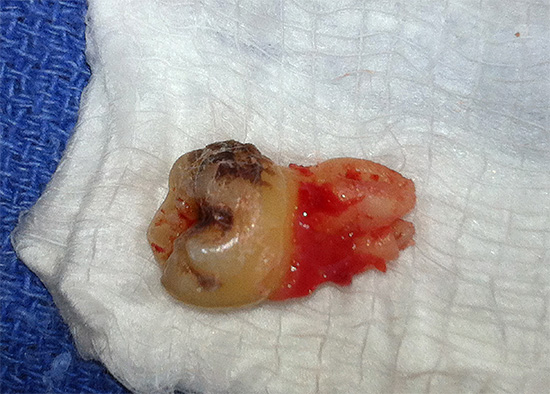
There are three main ways to stop the blood after tooth extraction:
- Clamp your teeth with a gauze pad for 20-30 minutes. You can make such a tampon with your own hands from a sterile bandage, but it is easier to buy ready-made sterile gauze wipes at the pharmacy. The principle of using this classic method is not to absorb blood, but to compress the edges of the hole, in other words, compression. The stronger the retention of the tampon between the teeth on the hole, the greater will be the chances to quickly stop the blood (the main thing - without fanaticism).
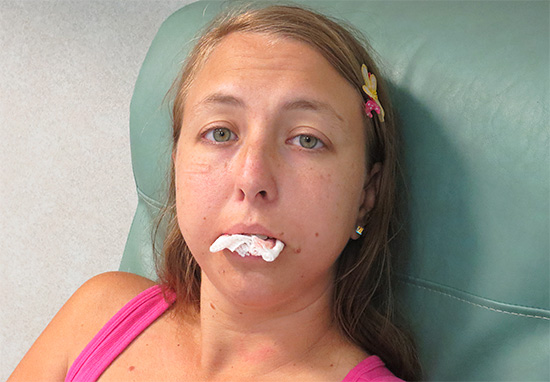
- If the first option did not have the desired effect and the blood still does not stop, then you can soak the tampon with a small amount of 3% hydrogen peroxide. The hemostatic effect is provided in this case due to the coagulating action of peroxide. Do not hold it too long: sometimes it takes only a few minutes to fully hold the gauze cloth between the teeth.

- And finally, the third way to quickly stop the blood after a tooth is removed is to purchase a so-called hemostatic sponge at a pharmacyand put a small piece of sponge with a gauze pad on the hole, tightly clamping it with his teeth. It is not easy to do this on your own, as ideally, the sponge should not just be on top of the wound, but also slam a little deeper. In fact, it is for professional use, but absolutely safe, although technically difficult to stop the bleeding on its own.
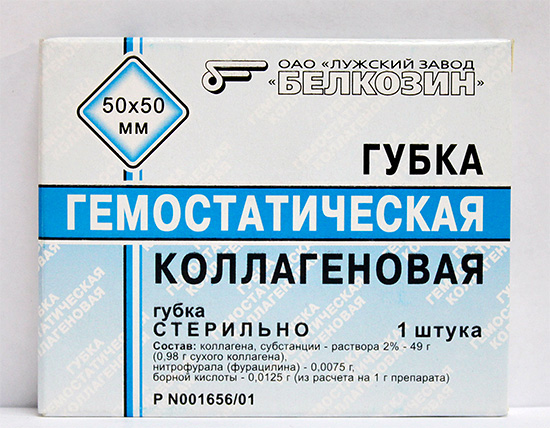
Having an idea of how to stop the blood at home after a tooth is removed is, of course, useful, but not always enough. The fact is that there are cases of prolonged bleeding from the hole due to serious illness or taking special medications. Therefore, this self-help may not bring the desired effect, and will only lead to the fact that precious time will be spent.
That is why, if after removing a tooth, the hole or gum stains for a long time and home remedies did not help for 1-2 hours, it is recommended to consult your doctor.
Bleeding after removing the lower wisdom tooth and methods for stopping it
About removing lower wisdom teeth (Eighth) and related bleeding should be discussed separately due to the special arrangement of these teeth. The fact is, they are located at the very end of the jaw, in the zone where they are surrounded by very abundant blood supply tissues. As a result, after the removal of a wisdom tooth, bleeding is often especially pronounced and long lasting.
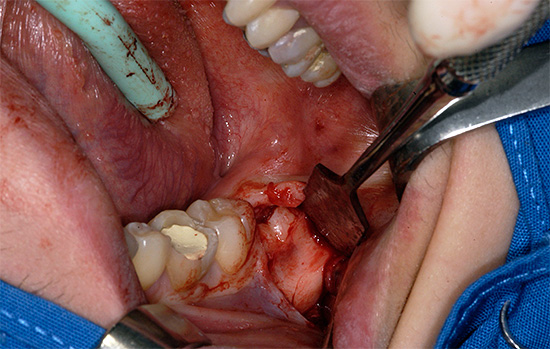
Despite this, the rate of formation of a blood clot after the removal of a wisdom tooth is the same 15-30 minutes, which was already mentioned above. Even if there was a complicated tooth extraction with a gum dissection, cutting out the roots, removing them in pieces from the hole and subsequent suturing the wound, the bleeding from the gums should still be normal in this period of time.
It is worth noting that the removal of wisdom teeth is generally considered an operation with relatively high complexity, because it is not by chance that in private clinics it is charged 3-4 times more expensive than an ordinary tooth. First of all it concerns the lower "eights", because it is these wise teeth that can be located crookedly or their roots intertwine with the roots of the adjacent teeth, creating additional difficulties.
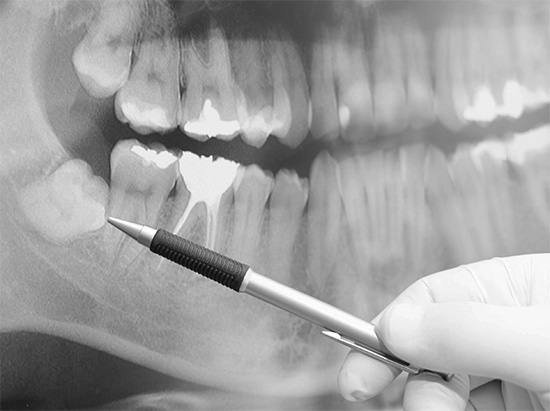
On a note
The danger during removal arises even from the very location of the wisdom tooth, when access is not easy, and the doctor has to perform the removal almost blindly. Sometimes there are quite terrible situations when during the procedure they can literally tear the mouth, as the doctor inserts instruments with great effort, and the mouth may not open as well as the position of the tooth requires. And although the “torn” mouth is just tears in the corners of the mouth, which, with proper treatment, heal in a couple of days, however, the sensations are very unpleasant.
In addition, a broken instrument can seriously cut the cheek with the gum. Then it will be necessary to stop the blood not only from the hole, but also from the accidentally received wound.
Bleeding can also increase in cases where the dentist opens the wound too far, as he needs to see deep roots and the viewing angle is small.
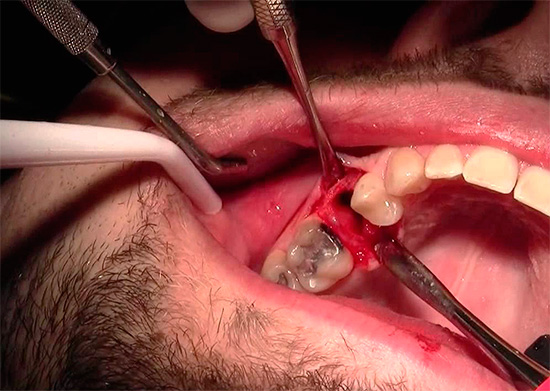
To stop long-term bleeding after the removal of a wisdom tooth, you can use the same methods that have already been mentioned above (although the result can be somewhat more difficult, since the wound can be quite wide).
If you see that you cannot achieve a quick effect yourself, then the best option is to quickly go to the dentist for help at the clinic. Prolonged incessant bleeding from the wound creates prerequisites for suturing the edges of the gums around the hole with the pretreatment of hemostatic agents.
Professional ways to stop bleeding from the hole (in the dentist’s office)
So, if after removing a tooth, the gum continues to bleed heavily, and a blood clot in the hole does not form within a few hours, then you should not wait and continue to bleed: it is better to seek professional help from a dentist. Or immediately provide yourself with emergency care, using simple ways to stop the blood. However, as mentioned above, one should not forget that it is not always possible to stop the blood at home.
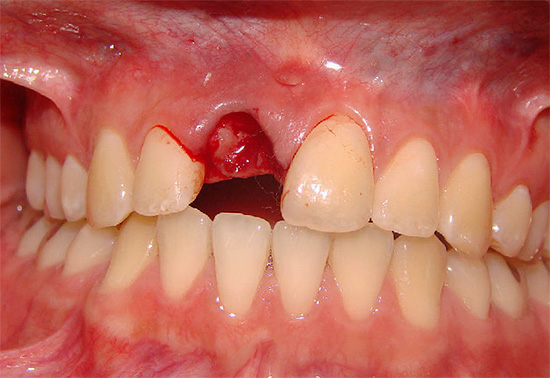
Suppose that you still turned to your dentist with your problem (usually refer to the same doctor who performed the removal of the tooth). Let's see what methods of stopping blood can be applied by a doctor - in general, such methods are divided into two groups: local and general.
Local ways to stop bleeding
If arterial bleeding occurs, in which blood flows out of the hole with a slightly pulsating stream, then the dentist-surgeon can bandage the injured vessel and stitch the torn gums.
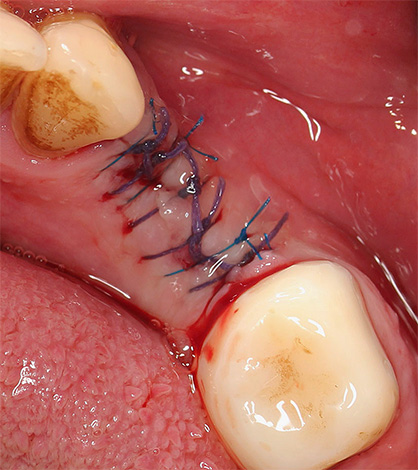
In case of injury of small vessels, electrocoagulation of the wound surface can be used to stop the blood.
If blood is bleeding after the tooth is removed from the wall of the hole or the inter-root septum, the bleeding is stopped by squeezing the area of the bleeding bone with bayonet tongs.
If the blood flows from the depth of the hole after the tooth is removed, then other approaches are used to stop the bleeding. In Soviet times, blood from the well was stopped using a tight tamponade with iodoform turunda (iodoform is a strong antiseptic). At the same time, iodoform turunda was introduced into the well in a special way: a strip was tamped from the very bottom, stacking in multiple layers and folding up to the very edges of the gums, which were then overlaid with sutures and gauze napkin. After 5-6 days, forced removal of turunda was required, which often did not lead to anything good, and sometimes also provoked repeated bleeding.
In order not to get into the delicate structures of the healing wound, self-absorbable hemostatic drugs were subsequently used. These include, for example, the following:
- Means made from human blood (hemostatic sponge, fibrin film);
- Means based on blood and animal tissues (gelatin sponge “Krovostan”, hemostatic collagen sponge, antiseptic sponge with gentamicin, which also provides antimicrobial properties, etc.).
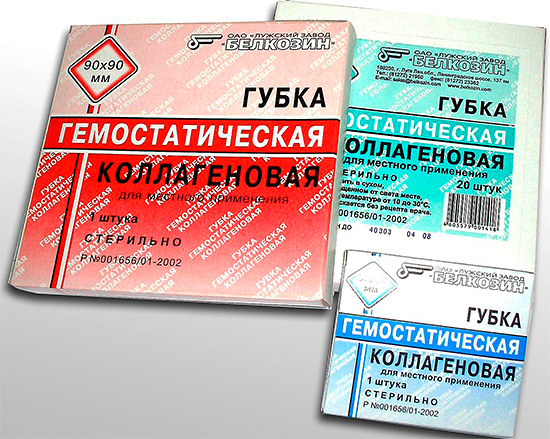
Common ways to stop bleeding from a tooth hole
If after the tooth is pulled out, the blood does not want to stop at all, then along with local methods to stop the bleeding, general methods can also be applied. Ideally, this option of professional help requires a series of tests and consultations of specialists (for example, a therapist, cardiologist, hematologist), however, in emergency situations, you can use injections of hemostatic drugs, so to speak, “before finding out” the true causes of severe bleeding.
Common methods for stopping blood from a tooth extraction hole include the following:
- Intravenous injections of 10% solution of calcium chloride and calcium gluconate;
- Intramuscular injection of 1 ml of 1% solution of Vikasol;
- Intravenous administration of 2 ml of a 12.5% solution of the drug "Detsinon".
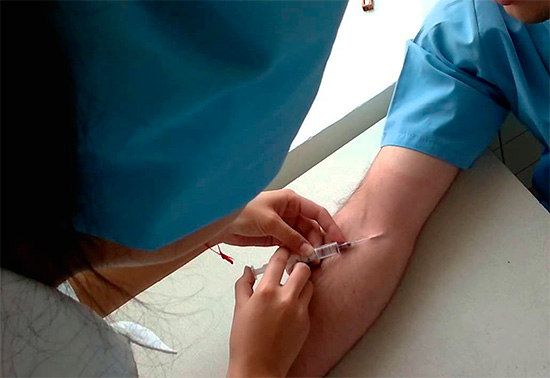
In hypertension, in addition to emergency general and local assistance in stopping bleeding from the gums after extraction of the tooth, it is necessary to conduct anti-hypertensive therapy with appropriate medications together with a general practitioner or cardiologist. Reducing blood pressure to normal levels almost always contributes to the rapid cessation of blood from the wound.
Useful video about the importance of blood clot formation in the tooth hole and possible complications in its absence
What can and can not be done immediately after tooth extraction

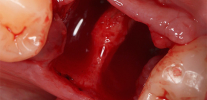
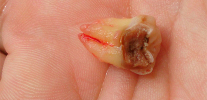
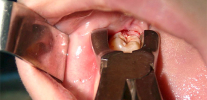
Disgusting photos, interfere with normally read the article ((
I fully agree with Anna, the photos are superfluous (
You have found the answer to your question - and this is important. So do not swear at the pictures, they are needed for work. All be healthy and strong teeth!
I don’t care about the photos, it’s more important to find a way to stop the blood after opening the lump at the upper tooth, which appeared a week after the incision ... Thanks for the tips. I'm going to use peroxide.
Ordinary photos. The article is intended for beginners or students (because they see it every day, doing their work). Here describe the algorithm of action. Obviously not for ordinary people who came to treat teeth. You will not be able to suture a wound due to all the rules, nor an injection. An article for dentists.
Hope, if heavy bleeding after removal, you must immediately contact the clinic where the tooth was removed, and do not self-medicate. This is all fraught with consequences. And most importantly - the loss of blood and time to stop bleeding.
Thank you, doctor! In my opinion, the topic of stopping bleeding after tooth extraction is very well and thoroughly covered. And it's good that there is now an opportunity on the Internet to find all possible options for the first "self-help". I personally heard / read everything before this in the article.
P.S. On numerous health forums, now any inquisitive and sensible person, having shown some patience, will find a lot of information. And others may instead look for defects and blemishes out of habit, expressing negative emotions as well, looking for the guilty instead of gratitude 🙂 It’s just amazing.
Good article. Photos to the site and perfectly illustrate the information.
You doctors, as usual, will not understand. The article says that if the bleeding is more than half an hour, then it is not normal and you should immediately go to the hospital. The second day I am bleeding profusely, and the dentist cackles that everything is normal and still accuses me of violating the surgeon's recommendations.
Hello! How many doctors have so many opinions)) It’s a joke, but the point is that your doctor is either incompetent in matters of dentistry, or I’m sure that you don’t have any bleeding, but a bitch that you spit out with saliva. If the examination was carried out in a chair, then the doctor, most likely, is right that there is nothing to fear. On the other hand, in his place I would put a hemostatic sponge in the hole for everyone who makes such requests. Reinsurance is sometimes more important because there is no criticism of the doctor and the patient.
Great article and photos. I had no idea what was there or how. I sit, a mouth full of blood clot. Hopefully stop flowing. The blood went 7 hours after removal. The photo is very helpful - at least I see the full picture of what I have now.
You would have stuck 100,500 characters of text here. Why not give advice immediately from above, and the rest of the nonsense about blood loss, etc. for those who want to clean down?
The blood went, went to the dentist, he poured powder and put a tampon. After I pulled it out, I had something white in the hole. Maybe it remained a bandage?
Hello! According to the information provided by you, I cannot answer this question precisely, since there are two possible options: either these are really remains of a gauze tampon or a hemostatic preparation that has been used. There is a lot of funds to help in such cases, and it is hard to say without inspection. I think that it is necessary to consult a doctor and accurately determine whether gauze remained in the hole as foreign material.
Immediately after the removal of the molar, blood was flowing for a long time, for about 40 minutes, then the blood appeared. It lasted more than an hour, then pink saliva went, and everything stopped. But I opened your article and tips, read and was pleased that I did not rinse my mouth, and the idea was to buy a napkin. I'm afraid to eat while waiting for more. In general, many thanks for the help of advice. Inspired!
So much water. Especially for the dentist.
Thank you very much for the article, everything is clear and on the shelves! For any reader, all the answers to the questions and very accessible!
Hello! I have after the removal of a wisdom tooth from below the third day saliva with blood. That is, I do not even swallow saliva, but constantly spit it out.Because saliva is bloody. The wound was removed after removal. You can say it does not hurt, but there is swelling. On the second day, the swelling became more. On the third or the same, or maybe a little slept, but the saliva is also with blood. Is this normal or not? The tooth was removed for a long time, and they pounded with a hammer. Thanks in advance for the answer to the dentist.
The lower wisdom teeth (eights) are located in a corner at the bend of the jaw and in most cases have curved curved roots, which makes it difficult to extract them from the jaw. Therefore, only teeth up to 4-5 are removed with forceps. In other cases, you have to resort to using other tools: chisels, hammers, and even drill with a drill along with the jaw section. The result is a wound with a crushed, chopped, torn surface. Such trauma leads to postoperative edema for up to 5-7 days, prolonged bleeding and poor healing. The inflammatory process leads to the formation of blood and an incomplete blood clot. Constant spitting leads to the displacement of a blood clot from its place and renewed bleeding.The admixture of even 1/50 parts of blood to saliva leads to its staining in red, but this is not bleeding. So just stop spitting out! You yourself partly provoke bleeding. The necessary suturing of the well has already been done to you, plus the doctor should have prescribed an additional drug treatment. Even so, the process of healing the hole after a traumatic removal of wisdom teeth takes 1.5–2 months and can be accompanied by pain and difficulty opening the mouth. Everything you describe is a common occurrence.
Hello! I agree with an experienced doctor. Dallock is a frequent occurrence, which is confused with bleeding. With complex deletions, especially - such traumatic, such phenomena are not uncommon. If you have a tendency to improve every day, then do not panic. Otherwise, contact your doctor to clarify the situation.
But how can one recognize whether it is bleeding or sukrovitsa? The second day after removal is not just pink saliva, but blood clots. I do not know what to do. The dentist said to put ice on his cheek.She also said that she had touched the artery.
Good afternoon, Maria. It is possible that a tooth artery was injured during tooth extraction. This happens and is the norm for complex deletions. Apply ice to the cheek through a cotton or linen towel for 10-15 minutes every hour (3-4 times). The presence of secretions (suckling or blood clots) is the norm after tooth extraction. Within 3 days everything should stop. If this does not happen, it is recommended to see a doctor.
The wisdom tooth was removed at 15 o'clock. It is now 18:28. The tampon was not removed, but dark blood is constantly accumulating in the mouth. Please tell me what I need to do? Thank you in advance.
Good day, Iraida. During the first 2 days after the extraction of the tooth, the hole may bleed - this is absolutely normal. During today (that is, on the day of tooth extraction), you can apply ice for 15-20 minutes through a cotton or linen towel every hour for 2-3 hours. Cold vasoconstriction and minimizes swelling after removal. It is also useful to monitor blood pressure (many anesthetics contain adrenaline, which constricts blood vessels and, as a result, increases pressure).
If the bleeding is severe and the blood does not stop for a long time, then you need to bite a gauze tampon in the area of removal and contact your doctor for examination and prescription of a hemostatic drug.
Need to make a decinon
Hello. I have 17 teeth removed from the top. The doctor said to hold the tampon for three hours and remove, I did so, but as soon as I removed it, blood gushed. Not dripping, but it flowed for several minutes. I tried to stop it, I managed to do it partially. To the clinic 20 minutes away, taking into account small traffic jams, I drove in 30 minutes. The doctor immediately tried to sew, but the blood flowed like a bucket. I realized that they could not stop, and I told him: we went to the hospital, we need to call an ambulance. He stuffed the hole with tampons and I bit them. The main stream stopped, and what was collected in the mouth, turned into clots, I spat out.
The ambulance arrived in forty minutes. I ended up in the maxillofacial hospital, and there were about five more stitches. During this time I lost more than a liter of blood. Tell me, please, why did blood flow? Maybe something hurt me?